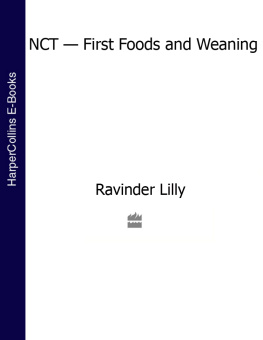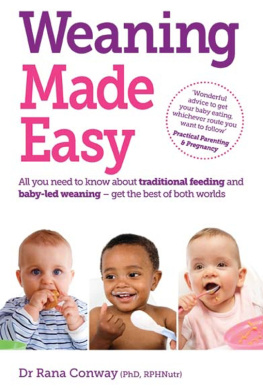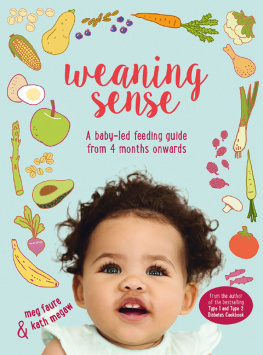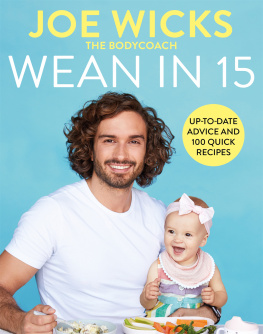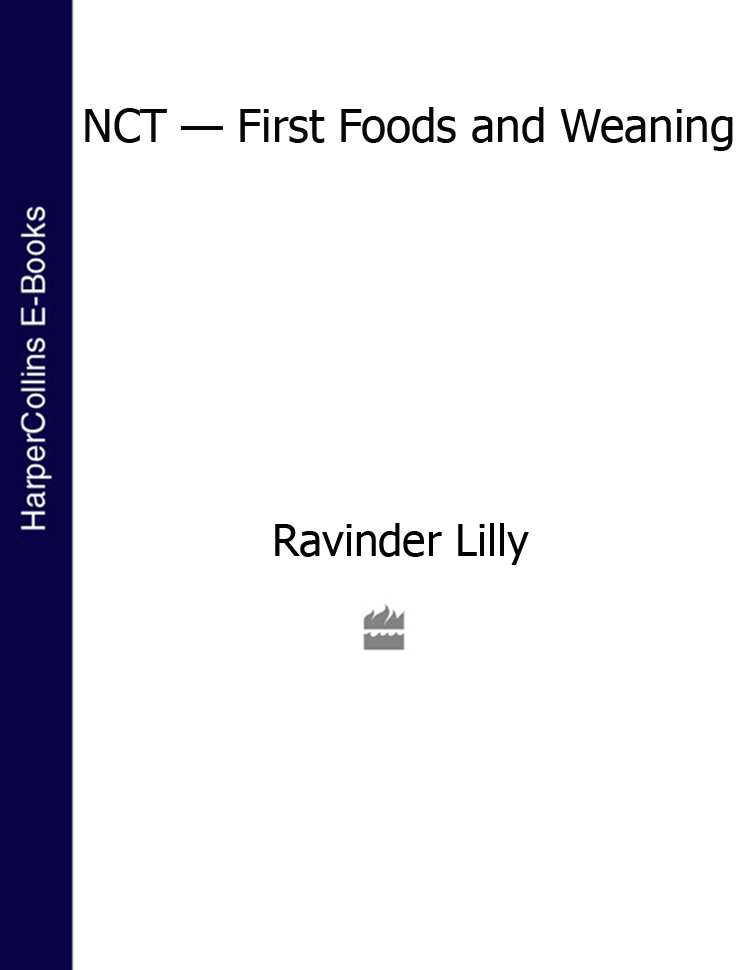He who has health has hope, and he who has hope has everything.
Contents

Eat Well Today for a Healthy Tomorrow
Food is one of the greatest pleasures of life, but it is also essential for life itself. The type of food babies and children eat regularly can affect their chances of having good health and ill health, and is just as important as getting enough food. Certain degenerative conditions such as heart disease, tooth damage, obesity and high blood pressure in later life have been linked with a poor or restricted intake of nutrients in early life.
Right from first tastes, your baby will start to set the foundations for eating habits in later life. So, even at this very early stage, it is important to encourage your babys interest in food and offer a healthy, varied diet.
What Makes a Diet Healthy?
The foods that experts recommend for adults today are very similar to those eaten by our distant ancestors. Once, much of our diet was composed of foods of vegetable origin: cereals, grains, pulses, vegetables and fruits. Meat, fish and poultry were eaten in smaller amounts.
These days there is no longer any need to hunt or forage for foods, and our supermarket shelves are laden with produce from all over the world, including many manufactured and processed foods that bear little resemblance to the original produce. Many more fatty, sugary and refined foods are available, but less marketing effort is made to encourage the appeal of vegetables, wholegrains and fruits. It seems that, although finding food has become much, much easier, eating well has become more difficult.
However a varied diet, with plenty of fresh whole foods, is all that is needed. Eating healthily need not be dreary or difficult. You dont have to force yourself or your family to eat foods that you hate choose from the huge variety of foods available and make up your own recipes. It neednt mean hard work, either just make one small step at a time until you are all eating healthily. Remember eat well today for a healthy tomorrow.
Ravinder Lilly

All foods are made up of one or more of the seven nutritional building blocks: carbohydrates, proteins, fats, vitamins, minerals (including trace elements), water and fibre. No single food contains all the nutrients essential for good health, so a healthy diet has to contain all these building blocks in the right proportions.
The Macronutrients: Proteins, Carbohydrates and Fats
Proteins, carbohydrates and fats provide the energy (calories) in the diet. Calories are the fuel needed to fire body processes, much as petrol in a car provides the engine with the fuel it needs. If more calories are consumed than are used, the spare energy is converted to fat and stored.
Proteins
Proteins are essential for the building and repair of cells and tissue. Proteins are themselves made up of smaller building blocks called amino acids.
Both animal and vegetable foods can supply protein. Proteins from animal foods (such as dairy produce and meat) provide all of the essential amino acids, while those of vegetable origin (cereals and grains) tend to be low in one or more essential amino acids. Mixing different types of non-meat proteins (like rice and pulses or bread and lentils) improves the quality of the protein intake and helps to ensure all the amino acids are obtained in the right proportions. Most people in the UK get enough protein in their diet, but vegans and vegetarians need to be careful that they are eating a good mix of vegetable foods. These foods tend to be less expensive than animal sources of protein and are lower in fat. Breastmilk is an excellent source of protein.
Animal Sources of Protein
meat
fish
poultry
eggs
dairy products like milk, cheese and yoghurt

Vegatable Sources of Protein
grains such as wheat, rice, millet and oats, and foods made from them like bread products and pasta
soya beans and products made from them like tofu
nuts and nut butters
seeds
lentils (red and green, for example)
pulses such as chickpeas, baked beans, red kidney beans and black-eye beans
bread and bread products
Carbohydrates
Carbohydrates may be divided into starchy or simple according to their chemical make-up.
The starchy (complex) carbohydrates in foods like potatoes, rice, pasta, yams, plantains, bread and cereals are a good source of fibre, and can be a rich source of vitamins and minerals.
The simple (refined) carbohydrates such as sugar are often termed empty calories as they provide calories but no other nutrients.
Humans have a natural liking for sweetness, which perhaps evolved as a type of natural defence mechanism: a fruit that is ripe and good to eat tastes sweet, while a food which is past its best, like milk which has gone off, tastes sour.
Today, refined sugar is cheap and freely available and is added to many manufactured foods. Eating high-sugar foods frequently will cause dental decay and experts recommend that sugary foods and drinks should be limited. Babies under one year old should not have sugar added to foods or drinks.
Fat
Fat provides the insulation material for our bodies, protects internal organs, and helps keep tissue healthy. Women tend to have more body fat than men and this is related to their reproductive function: fat is naturally laid down in pregnancy to provide the concentrated energy resources needed while breastfeeding. Fat is an essential nutrient, but most adults eat too much.
Fat provides the most concentrated source of energy; in other words, it provides a lot of calories in a small volume. Because of this, it is a very important nutrient for babies and young children who have high requirements for calories but small stomachs. It is also an important source of fat-soluble vitamins A and D, and indeed these vitamins would not be absorbed at all without fat. Babies and toddlers should not be given a low-fat diet.
Breastmilk and formula milk supply energy because they are high in fats, so it is important to offer either breast- or formula milk for at least the first year. Even after one year, your baby should continue to drink breastmilk or full-fat cows milk. If your toddler enjoys a mixed diet, semi-skimmed milk can be taken after two years, but skimmed milk should not be offered until your child is five years old.
Depending on their chemical make-up, fats are classified as saturated or unsaturated. There are three types:
- Saturated fats: These tend to be of animal origin (the exceptions are coconut and palm oil) and are usually solid at room temperature. Eating too much saturated fat has been linked with raised blood cholesterol and an increased risk of heart disease. Saturated fat is found in meat and meat products; dairy produce like cheese, butter, milk and cream, and in lard, suet and dripping. Experts recommend that this type of fat should be reduced in the diet.
- Polyunsaturated fats: These usually come from vegetable or fish sources and are usually liquid at room temperature. They can help to lower blood cholesterol and nutritionists recommend that some saturated fat should be replaced with the polyunsaturated oils found in nuts and seeds like sunflower, corn and safflower.

